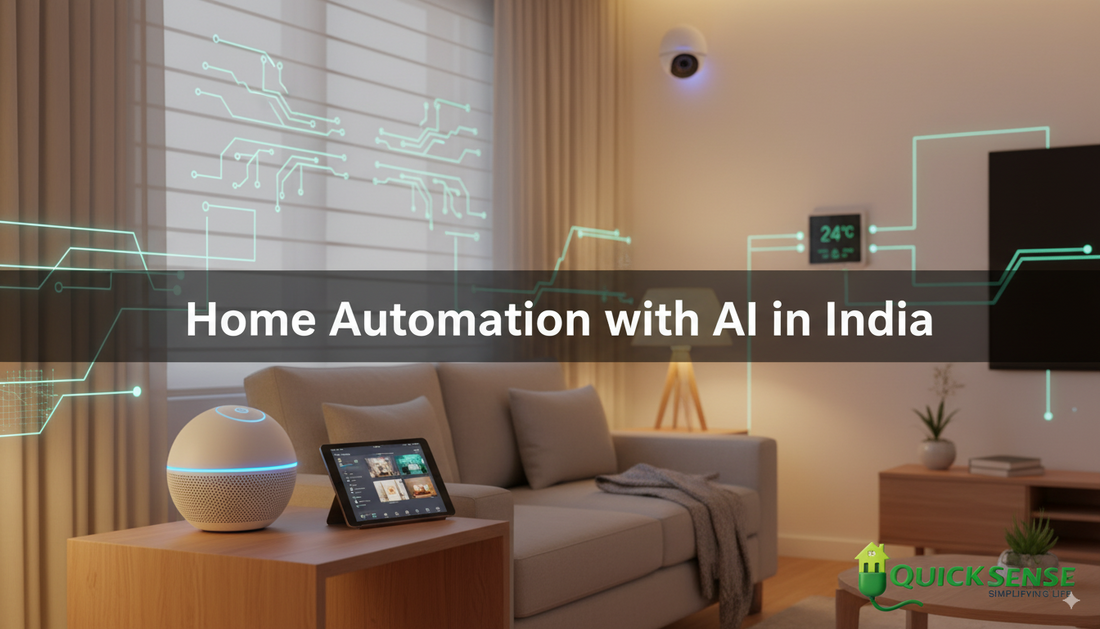
Home Automation With AI
Share
Introduction
In today’s fast-paced world, convenience, efficiency, and safety are no longer luxuries—they are expectations. Home automation powered by Artificial Intelligence (AI) is transforming how we live, offering intelligent homes that adapt to our lifestyle rather than us adapting to them. In India, where urbanization, rising incomes, and digital adoption are accelerating, the convergence of AI, IoT (Internet of Things), and smart devices is creating enormous potential for home automation.
What Is Home Automation with AI?
Home automation refers to the use of technology to automatically control household systems and appliances (lights, climate control, security, entertainment, etc.). When AI is layered in, the system can learn behaviours, predict preferences, respond to natural language, optimize usage, and improve over time rather than just follow pre-set schedules.
Some AI features include:
-
Voice control / Natural Language Processing (e.g. assistants like Alexa, Google Assistant)
-
Learning preferences: lighting, temperature, music patterns
-
Predictive control (e.g. anticipating when you will return home, adjusting climate or lights accordingly)
-
Energy optimization (turning off lights/appliances when rooms are unused, optimizing HVAC usage)
-
Enhanced security: facial recognition, anomaly detection, smart cameras
-
Health & wellness: air-quality monitoring, reminder systems, safety alerts
The Indian Market: Size, Trends & Growth
There are strong signs that the home automation + AI sector in India is on a steep growth path. Key findings:
-
The home automation market in India was valued at about USD 3.56 billion in 2024, and is projected to reach USD 13.64 billion by 2033, with a CAGR of ~16.10% during 2025-33. IMARC Group
-
The smart home automation industry (which includes AI and IoT components) is estimated to be worth ~USD 7,136.8 million in 2024 and expected to grow to ~USD 65,084.3 million by 2034. That implies a CAGR of ~24.8%. Future Market Insights
-
Another forecast puts the India smart home market at USD 5.20 billion in 2025, growing to USD 19.31 billion by 2030. CAGR of around 30% in this period. Mordor Intelligence
These figures suggest a rapidly expanding base of consumers, falling device costs, greater awareness, and improving infrastructure.
Drivers of Growth in India
What is pushing this growth? Some of the main drivers include:
-
Rising Disposable Income & Aspirations
As more households move to middle- and upper-middle income levels, demand for comfort, convenience, and prestige increases. -
Urbanization & Real Estate Trends
Apartments, gated communities, smart buildings are more amenable to integrating automation. In cities, lifestyle expectations include modern, smart conveniences. -
IoT & Connectivity
Improved broadband/5G connectivity, more devices with smart/network capabilities. Internet & smartphone penetration helps adoption. Future Market Insights+1 -
Energy Efficiency & Sustainability
Rising electricity costs, concerns about climate change, and government pushes for energy efficiency (e.g. smart meters, efficient appliances) are pushing people to adopt systems that save energy. IMARC Group+1 -
Security & Safety
Smart cameras, sensors, alarms, remote monitoring are becoming must-haves for many urban residents. Real-time alerts, anomaly detection, etc., add value. HData Systems+1 -
Government Initiatives
Smart Cities Mission, digital India rollout, pushing for smarter infrastructure. These provide ecosystem support, regulation, sometimes subsidies or incentives. Ken Research+1 -
Falling Costs & Greater Local Supply
As more local and international manufacturers bring cheaper sensors, devices, control systems, more automation becomes affordable for middle-class households. Interoperability protocols are improving. Future Market Insights+1
Challenges & What Holds Back Faster Adoption
To provide a balanced view, here are the hurdles:
-
Upfront Cost / Investment: Even if devices are cheaper now, high-quality smart systems (with good AI, security, reliability) can be expensive.
-
Interoperability & Standards: Many devices from different makers don’t always “talk” well together. Lack of standardization can complicate installations.
-
Security & Privacy Concerns: AI means data collection – voice data, video, behaviour patterns. Users often worry about data misuse, hacking, etc.
-
Awareness & Trust: Many consumers are still unaware of what is possible or hesitant to invest in something “new.” Also concern about maintenance, technical support.
-
Infrastructure Limitations: In some regions, unreliable power, poor connectivity, etc., can hamper effective deployment.
Opportunities & Scope Ahead
Given the market trends and drivers, here are areas with particularly strong opportunity:
-
Voice assistants in Indian Languages: Localized voice control in Hindi, regional languages will help adoption.
-
AI + Edge Processing: Systems that process more on-device (for privacy, faster response) rather than sending everything to cloud.
-
Smart Energy Management: Demand response (e.g. automating load depending on tariff), smart thermostats, intelligent lighting.
-
Remote Monitoring / Managed Services: Subscription-type models for monitoring, maintenance, security. Could help those who don’t want to manage tech details themselves.
-
Integration with Smart Grids, Solar, Electric Vehicles: Smart home systems could interact with national electricity policy, grid, rooftop solar systems, battery storage, EV charging.
-
Health & Assisted Living: Sensors for fall detection, elderly care, air quality, etc. These are big markets especially in an aging or health-aware population.
-
Affordable Solutions for Tier-2 / Tier-3 Cities: Tailored products that are more affordable, easier to install, low maintenance.
What Your Business / Customers Should Think About
If you are a business offering home automation (or planning to), or a consumer considering buying, you should:
-
Choose devices/systems with good security (firmware updates, encrypted communication).
-
Prioritize interoperability (open standards, hubs that can integrate multiple brands).
-
Think long-term: energy savings, maintenance, support.
-
Plan for user experience: ease of use, app control, voice, multilingual support.
-
Focus on clear value—for example, how much energy you save, how much convenience. ROI matters.
Conclusion
Home automation with AI is no longer just “nice to have” in India—it is becoming a key part of modern homes. With markets growing rapidly, technology getting cheaper, and more awareness among consumers, the scope is huge. For both businesses and consumers, now is a prime time to adopt, innovate, and invest in smart home systems. The homes of tomorrow are intelligent, adaptive, and deeply personalized.